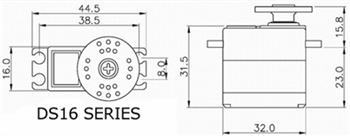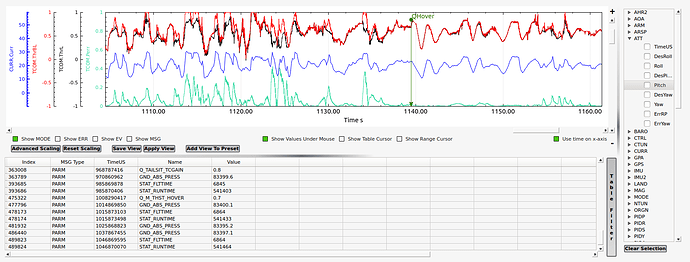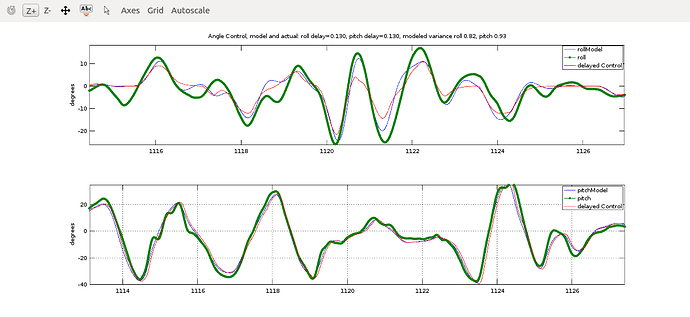OK ! how much ? so you think it’s not a belly sitter any more,… a tailbelly sitter( TVTBS)
@kd0aij,
Thanks for the detailed Params.
What is new with Function 77/78 compared to the “original” Function 4/19 I used?
Are this params in your post 184 still valid?
And are Function 77/78 for Servo 1/2 also for the vectored valid as kd0aij discribed in poste 453?
The new function doesn’t use the software mixer (param elevon_output is ignored) and it respects the PWM min/max limits for the selected elevon channels. This lets you adjust throws to avoid binding. You just need to set the channel reverse parameters correctly to get the elevons working properly. See:
@tridge New hover test log for the Stryker with reduced pitchrate P, I and D gains and thrust compensation:
Log 86 at https://drive.google.com/open?id=0Bw3digSMQXDuTHhadjZOX2JwZzQ
It looks like the digital servos and thrust compensation have resulted in very good pitch authority. Yaw authority is still quite poor though, but I’m not sure I want to risk losing pitch authority by turning up the yaw gain.
@tridge Successful Stryker flight today with forward and backward transitions using the throttle compensation patch. Wind was about 3 to 5 m/sec, and maintaining position in QStabilize mode was difficult due to the need to reduce throttle to avoid climbing. Control authority was good at hover thrust, and pitch authority was consistently regained when sufficient throttle was applied after each rather poorly controlled descent. Earth frame roll control was always solid, but the airframe’s tendency to weathervane consistently overpowered yaw control; I still haven’t tried increasing yaw gains.
Log and KMZ #87 here: https://drive.google.com/open?id=0Bw3digSMQXDuTHhadjZOX2JwZzQ
I’m hoping that a few enhancements to the throttle boost logic will make manual descents easier in wind while maintaining some control authority. Didn’t try Qhover in the wind since the required pitch angle was around 45 degrees and very rapid throttle changes were needed to avoid climbing. Note that the landing was at an attitude closer to nose level than nose up.
KML snapshot of landing in Qstabilize:
https://drive.google.com/open?id=0Bw3digSMQXDuVVJXcTNhYkZJSmM
I think it’s in the aircraft design and weight,the stright wing do all of the above, but in a much more controllable way, much easier to fly
@tilt Thanks for your advice; I’ve only worked with the PX4 “Caipiroshka” and my Stryker, and have no experience with other tailsitter airframes.
@tridge I moved the thrust compensation over to tailsitter.cpp as you suggested yesterday, and the results are very encouraging. With the new Q_TAILSIT_TCGAIN=0.8, and boost proportional to pitch error rather than demand, throttle management is much easier, and it still seems to guarantee good pitch authority, even with the yaw P gain increased from 0.1 to 0.25.
Log is #93 here: https://drive.google.com/open?id=0Bw3digSMQXDuTHhadjZOX2JwZzQ
Branch is: https://github.com/kd0aij/ardupilot/tree/mw-tailsitter-comp3
roll and pitch tracking in Qstabilize mode:
Hi All,
On the process of building Pixhawk controller tailsitter plane with custom airframe (non-vectored)
Just to clarify the big steps (from this build tutorial and several Tridge post in this forum) :
- Load latest ArduPlane firmware
- Following Tridge second post:
Pixhawk Main Output:
Plug motors into main_out(3-4) servo rail --> Correct?
Plug servo into main_out(1-2) servo rail --> Correct?
Set:
Q_ENABLE=1
Q_FRAME_CLASS=10 --> any guidance what the “10” mean?
For initial testing I’d also recommend setting:
Q_ASSIST_SPEED=0
If you have left throttle on channel 3 and right throttle on channel 4 then you would use:
SERVO3_FUNCTION=73
SERVO4_FUNCTION=74
Then test flight in QSTABILIZE and QHOVER mode.
Please add/correct the above steps if require.
Many thanks in advance
In an early post of Tridge he told me to use Output 5 and 6 for the motors
SERVO5_FUNCTION=73 Left Motor Output 5
SERVO6_FUNCTION=74 Right Motor Output 6
Correct, with the following setting:
SERVO1_FUNCTION=77 Left Elevon Output 1
SERVO2_FUNCTION=78 Right Elevon Output 2
Thanks @lorbass
Is there any rules on motor rotations?
Opposite directions or one direction only?
EDIT: from @lorbass post below :
Right motor : CW
Left motor : CCW
Thanks in advance
Yes, opposite directions, to compensate thrust.
I was told from NURI Experts to set right motor CW (seen from back) to compensate
the wing end verice.
Yaw (Copter mode) is produced by the elevons or new with the vectored Firmware by tilting the motors in oposite directions.
Hi Richard,
For my Video I used a part of one of yours to explain my motivation.
Do you agree?
By the way, did you solve the issue with your dancing striker?
Otto
Wow,That,s great, now I’l have to get a 3d printer!
are your files going to be available ? or can I order a set that fit a DH16 hyperon servo with a universal flat wing mount slot.[quote=“lorbass, post:473, topic:15302”]
did you solve the issue with your dancing striker?
[/quote]
kinda, I limited the tilt angle to about 70 deg.and tilted the airplane 20 deg.with some landing gear ,at 90 deg.I think the sensor was trying to correct yaw and roll or both at the same time.the stryker has my controller in it, not a pix.
Rick
@lorbass Great design and video, thanks for posting. I’d also be interested in printing similar mounts; just got a roll of PETG filament to try out. I use OpenSCAD for my designs and a miniKossel printer… What tools do you use?
Of course, here the .STL Files.
Servobefestigung L.STL (24.9 KB)
Bügel L.STL (86.0 KB)
Edit: Do not use the following file. I detected a structural error due to a SW Bug in the desigen Programm.
It will break behind the air opening
Träger L.STL (580.8 KB)
This design needs exacly the correct Servo Hitec HS-5070 MH, and Wing Team BlackSheep Online Store - Secret Project.
I could try to desing a unit for you, but I need really exact measures of the servo (normally not to find in internet)
and a shape of the wing as sketch with the measures.
Bevor the purchase of a printer, download the appropriate slicing SW(Normally free of charge).
And then check if a file of me can be read.
I use an old 3D CAD Programm called 3D Studio Kinetix which does no longer exist. (or with another name)
 [quote=“lorbass, post:476, topic:15302”]
[quote=“lorbass, post:476, topic:15302”]
but I need really exact measures of the servo
[/quote]
great, heres some info on the servo size, you should try these, http://www.hyperion-world.com/
also could it be just a slot say1/2"x1.5"x3" ? to make it slip it on to wing that is built to receive it
thanks
Rick

